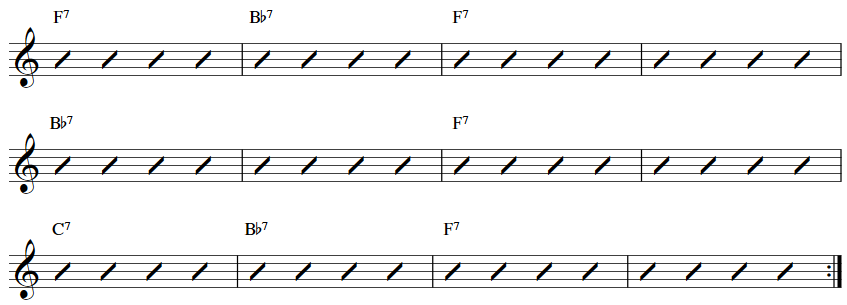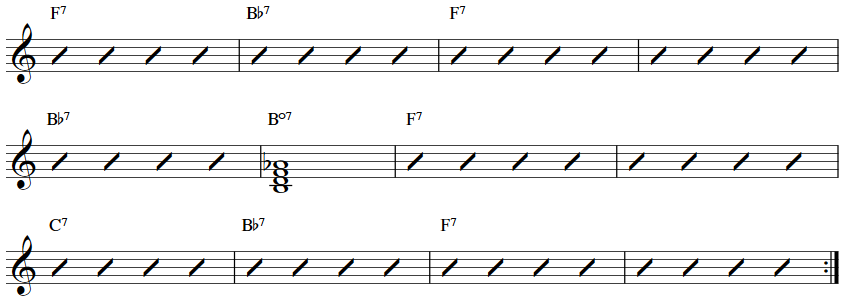Spice Up Your Blues Playing - 3 Tips

Wanna spice up your blues playing? Of course you do! Whether you’re into rock, jazz, blues, or funk, the 12-bar blues is a chord progression that you’re sure to encounter. In this article I’ll show you 3 ways to improve your blues playing, and they all start by gaining a deeper understanding of the harmony. That’s right, we’re talking chords here. Not licks, scales, or riffs. We’re digging deep into the harmony to learn a few ways to get some of those advanced, pro sounds that are so elusive.
Most of us know the basic chord changes to the 12-bar blues progression, which is based on three primary chords - the I, IV, and V chord (all dominant 7th chords) of a given key. Let’s take a quick look at the most basic form of the 12-bar blues progression in the key of F.
In each of the spice-enhancing tips below I’ll show you a chord (or chords) that can be substituted in order to create some more advanced harmonic options. You can use these new chords for both comping and improvisation ideas. We’ll use the F blues example throughout.
Tip #1 - Try playing a #IV diminished 7th chord in measure 6
Putting this chord in measure 6, immediately after the IV chord in measure 5, gives the progression a little bump that creates some more forward motion.
Why do we use this chord and how does it work? It’s really just an extension of the IV chord from measure 5. The IV chord (Bb7 in measure 5) has the following chord tones: Bb, D, F, and Ab. The #IV diminished 7 chord (B dim.7 in measure 6) has the following chord tones - B, D, F, and Ab. Notice any similarities?
They share most of the same chord tones. Think of the B diminished 7 chord as a Bb7(b9) chord (with a ‘B’ as its root). If you’re using the F blues scale for soloing, you can still use that same scale when soloing over the B diminished 7 chord.
Tip #2 - Insert a ii - V progression in measures 9 and 10
This simple chord substitution is quite common in jazz interpretations of the blues form. Inserting a “ii-V” progression means playing we will play a ii-7 chord (G-7) in measure 9 and a V7 chord (C7) in measure 10.
Doing this again creates forward motion to the F7 chord in measure 11 (thus, a “ii-V-I” progression). When soloing you can play a G dorian scale in measure 9, a C mixolydian scale in measure 10, and an F mixolydian scale in measure 11.
Or you can play the F blues scale through the entire progression.
Tip #3 - Put a V7/ii chord in measure 8
First off, what is a “V7/ii” chord (pronounced “Five seven of two”)? The “ii” chord refers to the G-7 chord we inserted in measure 9. So what we’re really trying to do is create some motion to the G-7 chord. What is the “V” of G-7?
The answer is D7. So we insert a D7 chord in measure 8 which resolves to G-7.
Many players will commonly use extensions on this chord, such as #9, b9, and b13. For soloing, use the F blues scale or try playing a G harmonic minor scale over D7.




Willie, you are the greatest teacher. You include information that is never taught by most instructors. I would say most don't know as much as yourself!
You make difficult sounding concepts into easy understandable language.
Thank you for all the free lessons you offer. You have spent years building the greatest site on the internet!!! You cover basic theory, and make it understandable to even the most beginning student!
Not to mention you can teach the most advanced, professional things they never knew!
Thanks again!
Thank you so much Nancy. I appreciate that. And I’m appreciative of our great team of teachers!